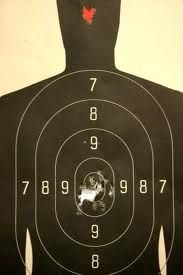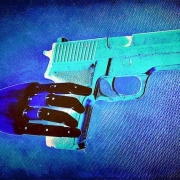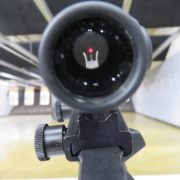Red Alert! Writers Need Assistance
It’s time to reach for the emergency switch that’s hidden beneath my desk, the switch that sends out a high-voltage shock to the writers who refuse to listen to the experts. You know who you are. You sit on your couches eating popcorn while watching fictional police-type TV shows, scribbling away as fast as your little fingers can write, making notes for your next scene. Well, let me be the first to say … STOP IT! There’s a reason they call that stuff fiction. Yes, someone made it up for our enjoyment. You know, like when you write a book based on the characters who live and work and play inside your minds. They’re not real and neither is a lot of the stuff you see on TV. Shocking, I know.
So, if you’re going for law-enforcement-realism I suggest you ask an expert—someone who’s actually in the business. Not an actor. Not someone who read about the subject matter and then wrote about it. Not someone whose sister’s husband’s cousin is married to a guy who knew a guy who worked in an auto parts store a block over from the police station.
No, you need to talk to someone who actually lives the life and has hands-on experience. Think about it … everyone (hopefully) uses a toilet during the course of a day, but that doesn’t make them an expert on plumbing. And when you need someone to work on that toilet you don’t call the guy from the auto parts store, right? Nope, you call a plumber. So why do you insist on relying on actors and screenwriters for your police information?
Anyway, here are a few things I’ve seen lately (again) that should never make it into your stories.
1. Cops DO NOT purposely shoot to wound. They’re not trained to do it, and they don’t. Police officers are taught to shoot center mass (the largest area) of their target.
And to be sure you understand where center mass is located, it’s the large hole in the target above. Again, cops do not shoot at arms, hands, guns, legs, and fingers. Not on purpose, anyway.
To learn more about why police officers aim for center mass and NOT please click this link to an earlier article.
2. Revolvers DO NOT automatically eject spent brass (cartridges). Pistols (semi-automatics) and automatic weapons do.
Do your stories sometimes include the use of handguns? Well …
REVOLVER V. PISTOL: DO YOU KNOW THE DIFFERENCE?
3. Cops always keep a round in the chamber of their weapons. Therefore, they DO NOT pull the slide back on their pistol when they’re about to enter a dangerous situation. To do so would eject a live round (bullet) from their weapon, leaving them one bullet shy of a full magazine. I already know quite a few cops who are one bullet shy of a full magazine. We don’t need more.
Someone once wrote me to say I didn’t know what I was talking about when I said that police officers always carry their handguns fully loaded, with a round in the chamber. They continued the rant by telling me (IN ALL CAPS) that it’s against the law to carry a live round in the chamber, even for a police officer.
Anyway, yes, police officers keep a round chambered at all times (with the safety off, if equipped). In fact, it’s almost second nature to do this when loading a weapon.
When you ask an officer how many rounds he/she carries in his/her weapon they’ll often respond with an answer something like, “Fifteen plus one.” This means they have a full magazine containing fifteen rounds and one in the chamber. Some officers take the answer one step further and include, “Plus I’m carrying two full magazines on my belt. That’s fifteen rounds each, for a total of forty-six rounds, including what’s in my pistol. Yep, I’m carrying forty-six rounds, four short of an entire box of ammunition.”
When loading their weapons, officers first insert fifteen bullets into the magazine. Then they shove the full magazine into the pistol, pull back the slide and then release it, which loads a round into the chamber. Then they eject the magazine and replace the round that was loaded into the chamber. They now have a pistol that’s loaded to 15+1, or whatever number of rounds their particular weapon holds.
Carrying a fully loaded handgun, with a round in the chamber, decreases the amount of time an officer needs to react when involved in a deadly shooting situation. The time an officer spends placing a round in the chamber could be the amount of time it takes to save his/her life.
When under fire, the last thing you want to do is to use up precious time chambering a round.
Did you know that a police officer’s quickest reaction time (based on a study of 46 trained officers), when they already know a threat is present, AND, with their finger already on the trigger, is 0.365 seconds. That’s far less than half the very brief time it takes to say “Supercalifragilisticexpialidocious,” the silly word from the Mary Poppins film. This reaction time does not include time to stop, draw a weapon from its holster, take aim, yell a bunch of commands, check for passersby, look for accomplices, and, well, you get the idea.
To read more about reaction time, please click this link.
SUPERCALIFRAGILISTICEXPIALIDOCIOUS: THE TIME IT TAKES TO DIE, SEVERAL TIMES
4. Cops DO NOT “thumb off” the safety when they’re entering a dangerous situation. Police officers DO NOT carry their weapons with the safeties engaged (on). Their duty weapon must be ready to fire at all times. That extra second it takes to think about flipping off a safety could cost them their life. That’s if they remember to do it at all while under fire. Believe it or not, folks, bullets flying around your head is actually pretty stressful, so you may not be thinking all that clearly. Also, please do a little research about the weapon carried by your protagonist. It may not even have a safety SIG Sauers, for example, do not.
5. Revolvers typically DO NOT have safeties.
6. Prisons are NOT country clubs. Even the lower-level federal prisons are tough. Sure, there are fewer restrictions and less supervision in the camps, but living in a locked building and having minimal food tossed your way a couple of times a day ain’t exactly living like a king.
7. It’s a rare occurrence, if ever, for an officer to come from one department and go to another and start out as a detective. Typically, one starts at the bottom and works their way back up the ladder.
8. The FBI does not ride into town and take over cases from small town police departments. They’re not some omniscient “see all” entity that knows when every single crime occurs. Someone from that town would have to call them and ASK for their assistance. Sure, they’ll help, and they’re great about doing so. Besides, as a rule, they don’t work murder cases.
Every officer in every single police department in this country is perfectly capable of investigating their own cases. Yes, their resources may be limited, but they have the knowledge and training to investigate crime. By the way, FBI agents do not have authority over local police officers. So please don’t have them ordering the local sheriff around. It does not happen like that in real life.
9. Yes, there is a provision in the law that allows a police officer to deputize a private citizen in an extreme emergency. Does this happen? Rarely, if ever. Sometimes investigators call on various experts for their assistance and advice, but there’s no need to deputize them, and they don’t. If the officer(s) needs more hands to work a case, they’ll simply call on a neighboring jurisdiction—sheriff’s office, state police, or another town. Now that does happen quite often. But to deputize a private citizen … nope.
10. Finally, please DO NOT give your readers an informational overload. Realism is very important, but to write something that belongs in a gun catalog … not good. Don’t bore your readers. You DO NOT need to show off your extensive knowledge of a particualr subject matter.
For example:
Bobbie Sue climbed into the pilot’s seat. Her best friend, Bucky McDoodoo, slid into the other. She’s never flown a plane before, but she’d seen grownups do it on TV, so how difficult could it be? She glanced around, her eyes taking in all the shiny buttons and gleaming dials and gauges. The 1978 Cessna 185 Skywagon N44TU, with its fixed landing gear, 300 horsepower (for takeoff), and 88 gallon fuel tank, would be perfect for the fun afternoon she had in mind. I mean, what other tiny plane with an overall length of 25ft. 8in. and a wingspan of 35′-10″ could tool along at a cruising speed of 145mph with a range of 645 miles. And all for only $130,000. What a deal!
Bobbie Sue giggled, barely able to contain her excitement, as she began to search for the ignition key and CD player. “Hang on, Bucky. Here we go!” she said.
Just for fun … An Eyewitness










